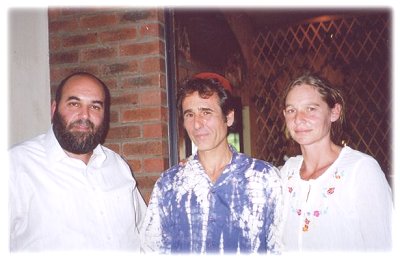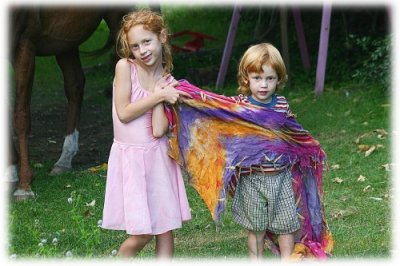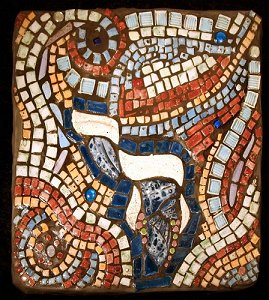|
BABES IN THE WOOD JEWISH FAIRYTALE
SWELLENDAM - JANUARY 2007

"Travelling Rabbi" Moshe Silberhaft, with Tovi and Maiyan Karidi

Babes-in-the-wood Mistorin and Keshet Karidi

A "chai" incorporated into one of their classical mosaics
The story of Maiyan
and Tovi Karidi and their children, Mistorin (9) and Keshet (5), is
akin to a Jewish version of a babes-in-the wood fairytale.
The woods are the green forests on the outskirts of the country town
of Swellendam, a two-hour drive from Cape Town, and the babes are
the family who live among the myriad creatures that inhabit the lush
vegetation.
Home schooled, Mistorin and Keshet, are totally unaccustomed to city
life. Keshet even shuns a shopping spree to the nearby town of
Worcester and cannot wait to run free in the land surrounding his
home. His sister, dressed in her ballet clothes, dances around the
forest like a woodland nymph.
Like their parents, they are fluent in Hebrew and English, but the
three children of an Israeli couple, who work in a fruit-packing
concern in Swellendam are the only real contact they have with their
peers. There is no telephone as there is no available line and no
cellphone reception in the area. Maiyan keeps in touch with the
outside world when she takes her computer and cellphone to the
closest reception point. They drink pure water and live off the
fruits and vegetables of the land, always cognizant of kashrut.
For Tovi, a sabra and Sephardi Jew, with family roots in Turkey,
sports a Bucharan kippah and wears tzitzit under his tie dye shirt
and jeans. Maiyan is like a maiden of the forest in her tzniyus top
of white cotton and flowing skirt. A mosaic artist, Hebrew-English
linguist and former equestrian, she was born and raised in Cape Town
before working on Kibbutz Nahal Oz in Israel and Moshav Ein Habesor,
as well as attending ulpan in the late 1980s.
In 1993, she returned to Israel to teach English privately and work
in childcare. In addition to furthering her linguistic studies, she
worked and trained in an archaeological dig in Caesarea, where she
restored ancient mosaics and frescos. It was there she met Tovi, the
artistic creator of exquisite ceramics, which he says are “Divinely
inspired”. They were married in November,1997.
Back in South Africa, Maiyan assisted her new husband with an art
course for children, as well as with maintenance and interior
design.
The next year the Karidis built a house in the shape of a Magen
David, with mosaic features (mosaics are their passion and their
profession). The house is perched atop a hill adjacent to a
waterfall which joins a stream that runs into a river. Because of
the hill and the running waters bypassing their home, the Karidis
were the only people near the river, whose home was left standing
after a massive flood in 2004. But it wasn’t as easy as all that.
“We were stranded with no form of communication for five days,
surrounded by swirling waters with debris from all the houses that
were destroyed. Deep freezes, television sets and refrigerators
floated past us, as well as all the snakes and animals that drowned
in the flood. We were beginning to think we would never escape and
then, miraculously, a helicopter arrived and lifted us to safety.”
During the same year the Karidis established a pottery studio –
Mystica Mosaics - and created their own wood-fired ceramic tesserae
for mosaics and wall art.
In 2005 they were commissioned to build a water feature and mosaic
for a 300 square foot surface at the entrance to an art gallery in
Swellendam.
“We are different because we make all our own pieces by hand as
opposed to most mosaic artists who buy commercial pieces and
assemble them,” said Tovi.
His wife adds: “Throughout our commissions, we manage to incorporate
into the mosaics some form of Hebrew lettering or Jewish symbolism,
of which our non-Jewish patrons remain totally unaware. They ask us
for all sorts of designs, but I draw the line when asked to do a
crucifix.
But this idyllic lifestyle has its drawbacks. The Karidis feel their
children are becoming isolated and need to grow up in a Jewish
community, although they observe Shabbat and festivals, when Tovi
conducts services. He is especially proud of the succah they built
on a deck over the river.
“The children are at home with nature. They fearlessly identify
poisonous snakes and scorpions and are totally au fait with the
drill. But this way of life cannot go on forever,” said Maiyan.
The work of “Travelling Rabbi” Moshe Silberhaft, of the African
Jewish Congress and Country Communities Department of the South
African Jewish Board of Deputies, was brought to the attention of
the Karidis.
They put their problem to Rabbi Silberhaft, who drove out from Cape
Town to see them, with a view to assisting them to settle on the
Island of Mauritius, where he recently opened a shul and Jewish
centre for the 70 Jews living there.
Tovi greeted the rabbi with the washing of hands, a mark of respect,
according to Turkish Jewish custom. Maiyan told the Rabbi:
“Mauritius to us represents the best of both worlds – the natural
beauty outside of city life, but with Jewish community living as a
bonus. I have a vision: How wonderful it would be to work on a
surface – the wall or floor of the building that belongs to the
Jewish community on the island. We could do a Jewish theme and
people (especially Jewish tourists) could come and watch the process
while we are at work. And we would relocate our studio there.”
Tovi feels they could also train locals with a view to job creation
in the tourism industry. He has magnificently handcrafted mezuzah
covers, seder plates and other Judaica.
Rabbi Silberhaft, who has the reputation of caring for every single
Jew, no matter how far from a city he or she lives, says he will set
the ball rolling with Mauritian Jewry and help wherever possible.
“We’ll give it a good try and let our children have a chance to grow
up there,” said Maiyan.
“This is our time to move on,” Tovi adds. “And when, in the future,
the next time comes around, we will go home to Israel.”
Maiyan and Tovi have a website:
www.mysticamosaics.com |


